“Our adversaries are not just thinking in terms of matching us in materiel, but also in terms of people and approaches to warfare. They are challenging each of these pillars, which for many in the Army have become cherished truisms. The dominance that we achieved is not a fact of life, but is instead a contest in which we engage each day. We cannot rest on our laurels, but must instead find new ways to equip, train, and lead the greatest fighting force in the world.”
— GEN Paul E. Funk II, CG, TRADOC
[Editor’s Note: The U.S. Army Training and Doctrine Command (TRADOC) has approved and published The Operational Environment (2021-2030): Great Power Competition, Crisis, and Conflict. This document is intended to complement previously published Operational Environment (OE) documents, expanding and adding to our understanding of the OE in light of recent events — think of it as an addendum. The document explores the impact of COVID-19 on the OE and presents four potential post-pandemic alternative futures to consider in terms of Competition, Crisis, and Conflict. It addresses China as our designated Pacing Threat and Russia as a near-peer threat; and describes their respective efforts to modernize and challenge the Army’s dominance in the land power domain as they endeavor to prevail in Competition, Crisis, and Conflict against the United States. This document also explores the impact of Climate Change on the OE and the associated challenges and opportunities facing the Army. Additionally, it is aligned with, and informed by, the Joint Operating Environment 2040, the Interim National Security Strategy, and Chief of Staff of the Army (CSA) Papers. Today’s post features an excerpt of its Key Judgements; a link to the comprehensive document may be found at the conclusion of today’s post, along with a host of additional, informative links — Read on!]
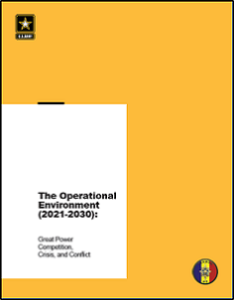 The Operational Environment (2021-2030): Great Power Competition, Crisis, and Conflict is intended to build on the Operational Environment (OE) analysis found in TRADOC Pamphlet 525-92, The Operational Environment and the Changing Character of Warfare. While that document focused heavily on OE conditions, namely on the development of new technologies and their impact on warfare, it paid less attention to the activities of our Pacing Threat, China, and our other near-peer threat, Russia. Furthermore, although it referenced pandemics as a
The Operational Environment (2021-2030): Great Power Competition, Crisis, and Conflict is intended to build on the Operational Environment (OE) analysis found in TRADOC Pamphlet 525-92, The Operational Environment and the Changing Character of Warfare. While that document focused heavily on OE conditions, namely on the development of new technologies and their impact on warfare, it paid less attention to the activities of our Pacing Threat, China, and our other near-peer threat, Russia. Furthermore, although it referenced pandemics as a 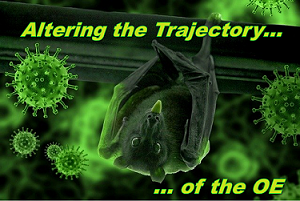 possible threat to the Homeland, the impacts of the COVID-19 pandemic on the OE represent a significant shock to the system that required new analysis, the context of which is addressed in Chapter 1.
possible threat to the Homeland, the impacts of the COVID-19 pandemic on the OE represent a significant shock to the system that required new analysis, the context of which is addressed in Chapter 1.
Chapter 2 presents the efforts of China and Russia to develop and modernize their militaries and focus on prevailing in Competition, Crisis, and Conflict against the United States.
-
-
- While the United States was engaged in counterinsurgency operations in Iraq and Afghanistan, our adversaries studied us and determined that the best way to defeat the United States is to win without fighting.
-
-
-
-
- China and Russia will contest us in every domain and across the diplomatic, information, military, and economic (DIME) spheres in Competition, Crisis, and Conflict.
-
-
-
-
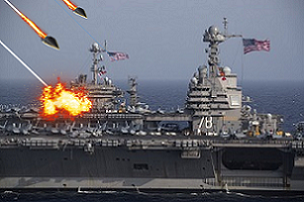 While the United States invested in equipment and capabilities for the counterinsurgency fight, our most formidable adversaries invested in capabilities that provide them with a degree of overmatch in a few key areas.
While the United States invested in equipment and capabilities for the counterinsurgency fight, our most formidable adversaries invested in capabilities that provide them with a degree of overmatch in a few key areas.
-
-
-
- Technology among peer and near-peer competitors will be roughly equivalent; the side with the best people and the best approach to Competition, Crisis, and Conflict will have the advantage.
-
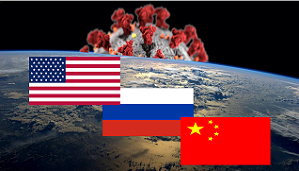 Chapter 3 focuses on the COVID-19 pandemic, and most importantly, on its impact on the OE in terms of the power dynamic between the United States, China, and Russia. It offers four potential alternative futures—called worlds—to consider the impact of the pandemic in terms of Competition, Crisis, and Conflict.
Chapter 3 focuses on the COVID-19 pandemic, and most importantly, on its impact on the OE in terms of the power dynamic between the United States, China, and Russia. It offers four potential alternative futures—called worlds—to consider the impact of the pandemic in terms of Competition, Crisis, and Conflict.
-
-
- The Status Quo Reprieve world represents a continuation of the pre-COVID-19 OE with little real change resulting from the pandemic. This means China and Russia will continue to develop their capabilities along a steady track toward contested equality around 2030.
-
-
-
- The Relative Advantage world postulates a future in which the impacts of the pandemic on the United States, China, and Russia are relatively equal, but the centralized authorities and economies of China and Russia allow them to focus more on defense than a general recovery, as in the United States. In this case, the OE speeds up, and China and Russia pose a significant challenge by 2025-2028. We view this as the most likely outcome.
-
-
-
- The most dangerous outcome is the Mind the Gap world, in which our adversaries recover quickly, while the United States craters. Under these conditions, our adversaries’ modernization programs rocket forward, posing a direct challenge to the United States in the next few years.
-
-
-
- Finally, the best case (but least likely) outcome is the New Renaissance world, in which the United States’ ability to innovate allows it to recover more quickly, while our adversaries struggle. This allows the United States to outpace its rivals across the DIME spheres.
-
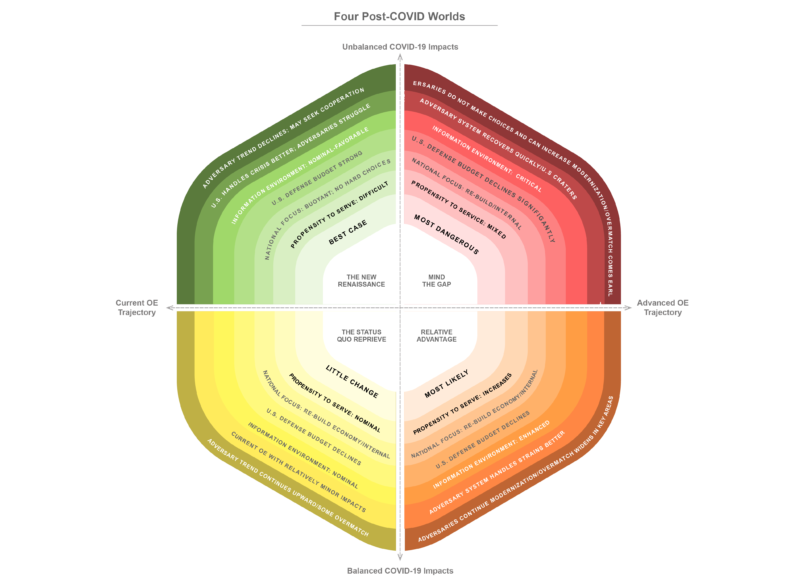 Chapter 4 provides a deeper insight into the impact of our adversaries’ modernization efforts, which directly challenge the key pillars of the U.S. Army’s post-DESERT STORM dominance in the land power domain.
Chapter 4 provides a deeper insight into the impact of our adversaries’ modernization efforts, which directly challenge the key pillars of the U.S. Army’s post-DESERT STORM dominance in the land power domain.
-
-
- Our dominance rested on three assumptions:
-
-
-
-
- We are the best equipped Army in the world;
-
-
-
-
-
- We have the best trained Soldiers and the most dynamic leaders; and
-
-
-
-
-
- Our ability to conduct maneuver warfare is unmatched.
-
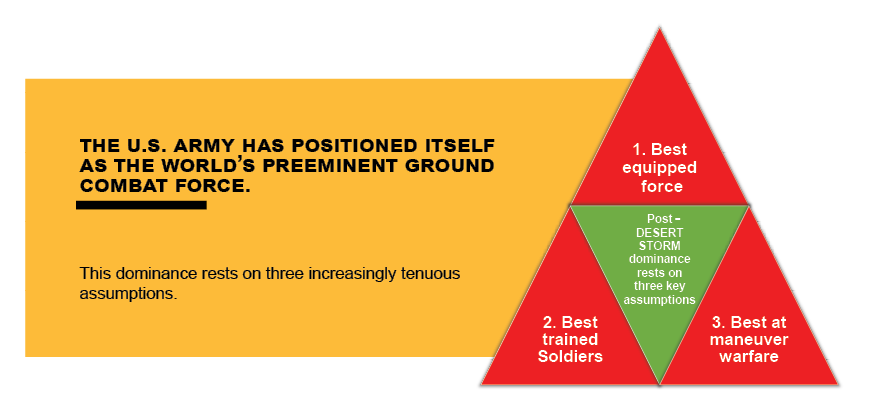
-
-
-
- This dominance was the result of efforts the Army made across doctrine, organization, training, materiel, leadership and education, personnel, facilities, and policy (DOTMLPF-P).
-
-
-
- While there is much focus on the materiel aspects of our adversaries’ modernization efforts, materiel advantage may be fleeting.
-
-
-
- Our adversaries understand this and are contesting us across the other factors that deal with human capital; these advances may be more long-lasting.
-
-
-
 Our adversaries have conceived of new approaches to warfare, namely China’s “intelligentized warfare” and Russia’s “New Generation Warfare” concepts. Both adversaries hold large-scale exercises designed to practice these approaches and to improve their forces. They have emulated the U.S. military in developing new combat training centers and are designing new professional military education systems that aim to create a culture of learning.
Our adversaries have conceived of new approaches to warfare, namely China’s “intelligentized warfare” and Russia’s “New Generation Warfare” concepts. Both adversaries hold large-scale exercises designed to practice these approaches and to improve their forces. They have emulated the U.S. military in developing new combat training centers and are designing new professional military education systems that aim to create a culture of learning.
-
Opportunities exist for the U.S. Army to future-proof the force. For instance, the Army can potentially overcome materiel capacity challenges from our adversaries by reshaping the force to be faster, more adaptive, more lethal, and one equipped with cost-informed systems more easily produced at scale.
The U.S. military can lean on the unique strengths of its allies in NATO and 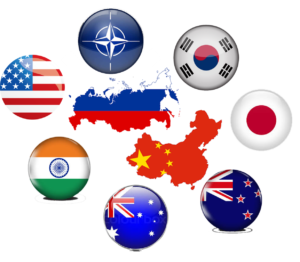 throughout the INDOPACOM region. Common purpose with like-minded states adds significant value in Competition, Crisis, and Conflict—particularly when the many of the adversaries’ allies are the victims of coercion.
throughout the INDOPACOM region. Common purpose with like-minded states adds significant value in Competition, Crisis, and Conflict—particularly when the many of the adversaries’ allies are the victims of coercion.
If you enjoyed this post, download and check out The Operational Environment (2021-2030): Great Power Competition, Crisis, and Conflict in its entirety here.
Explore the U.S. Army’s single consistent OE narrative (spanning the near, mid-, and far terms out to 2050) further in:
Four Models of the Post-COVID World, The Operational Environment: Now through 2028, and Threats to 2030 video
The Future Operational Environment: The Four Worlds of 2035-2050, the complete AFC Pamphlet 525-2, Future Operational Environment: Forging the Future in an Uncertain World 2035-2050, and associated video
Learn more about China as our Pacing Threat in the following TRADOC G-2 content:
ATP 7-100.3, Chinese Tactics; People’s Liberation Army Ground Forces Quick Reference Guide; China Tri-fold; the China products page; and information on PLA weapon systems accessed via the Worldwide Equipment Guide (WEG) on the OE Data Integration Network (ODIN).
… and the following Army Mad Scientist content:
China’s PLA Modernization through the DOTMLPF-P Lens, by Dr. Jacob Barton
“Intelligentization” and a Chinese Vision of Future War
Competition and Conflict in the Next Decade
Disrupting the “Chinese Dream” – Eight Insights on how to win the Competition with China
Competition in 2035: Anticipating Chinese Exploitation of Operational Environments
Disinformation, Revisionism, and China with Doowan Lee and associated podcast
The PLA and UAVs – Automating the Battlefield and Enhancing Training
A Chinese Perspective on Future Urban Unmanned Operations
China: “New Concepts” in Unmanned Combat and Cyber and Electronic Warfare
The PLA: Close Combat in the Information Age and the “Blade of Victory”

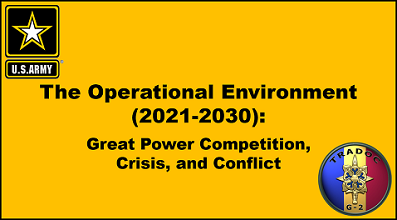
 In Conflict, our adversaries want to use stand-off capabilities to
In Conflict, our adversaries want to use stand-off capabilities to 
